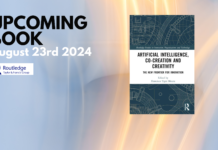I am thrilled to share that my commentary, “Artificial Intelligence, Creativity, and Intentionality: The Need for a Paradigm Shift.,” has been published in the esteemed Journal of Creative Behavior.
This commentary delves into the emerging role of artificial intelligence (AI) in creative processes and how it challenges our long-held beliefs about human intentionality and creativity.
As AI continues to advance and become more integrated into our daily lives, we are witnessing a paradigm shift in how we understand creativity. No longer is creativity solely the domain of humans, but now AI systems can generate high-quality content in written, image, video, and sound formats. These creative AI systems not only challenge our assumptions about intentionality and creativity but also open up a world of co-creation possibilities between humans and AI.
In my article, I argue that we need a new paradigm to account for the growing role of AI in creative processes. This paradigm should view intentionality in the synergistic co-creative relationships between humans and AI as equally genuine as those that don’t involve AI. At the same time, it should recognize the increasing intentionality of algorithms themselves.

One of the key points I make in my paper is that AI has democratized the ability to generate creative outputs, allowing anyone to express their aspirations, emotions, and thoughts without needing expert skills or knowledge in a particular area. While this may initially challenge the perceived value of human intentionality in creative tasks, I argue that AI should be seen as a tool that augments human creativity, not as something that diminishes it.
As we move towards a future where AI becomes an integral part of creative processes, we must also consider the ethical and legal implications of this new paradigm. Issues such as intellectual property, authorship, and responsibility for creative outputs will need to be addressed, adding further complexity to the discussion around creativity and intentionality.
Finally, as technology continues to drive societal change, it is crucial that future research on creativity addresses the ongoing paradigm shift across various sectors and levels of human involvement with technology. This includes investigating the intentionality of autonomous systems and artificial co-creation and adapting to the ever-evolving technological advancements.
In conclusion, the fast adoption of AI tools in the creative sector presents both challenges and opportunities for our understanding of intentionality and creativity. By embracing a new paradigm that recognizes the synergistic relationship between humans and AI, we can better appreciate the value of co-created outputs and the unique contributions of both humans and AI systems. I am excited to be part of this ongoing conversation and hope that my commentary in the Journal of Creative Behavior will inspire further research and debate in this fascinating area.
Have a beautiful day.





